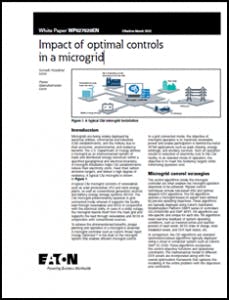A new white paper from Eaton explores how commercial and industrial (C&I) establishments can reach their economic, resilience and sustainability objectives through the use of optimal dispatch (OD) microgrid control strategies.
Get the full report
According to a new white paper from Eaton, “A microgrid installation helps C&I establishments reduce their electricity costs, meet their carbon emission targets, and deliver a high degree of resiliency.” The controller is a key component of every microgrid as it manages the flow of electricity from distributed energy resources and allows the system to completely disconnect from the grid in the case of an outage.
Eaton explains that there are two popular microgrid control techniques — rule-based (RB) and optimal dispatch (OD) algorithms. These control techniques are designed to meet the primary objectives of the microgrid, whether those are economic-, resilience- or sustainability-based.
In general, OD algorithms are robust and more effective as compared to RB algorithms to achieve the microgrid control objectives, but OD algorithms have more computational and input data requirements. — Eaton, “Impact of optimal controls in a microgrid“
The white paper provides real-world examples illustrating why the optimal controls approach is superior to a rule-based approach. A use case shows how optimal dispatch helped the Eaton manufacturing facility in Wadeville, South Africa, achieve a greater reduction in its electricity costs than could have been found with a rule-based approach. The authors also provide an example showing how optimal controls can deliver greater resilience.
The final illustration explores how an OD microgrid control strategy can reduce carbon emissions. The authors note that in their example, the OD solution is expected to reduce carbon emissions by a monthly average of 43% “in a scenario with perfect load and PV forecast, as compared to a base case where the entire load is served by the electrical utility.” Download the paper for free from the Microgrid Knowledge white paper library.









